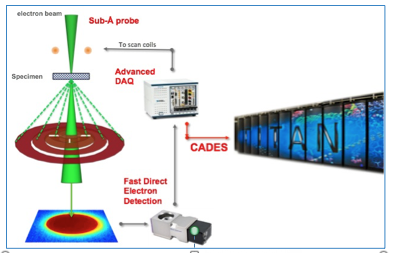
A graphic illustrating the coupling of advanced microscopes, data analytics, and high-performance computing to accelerate materials science. Resources at Oak Ridge National Laboratory, including CADES and the OLCF’s Titan, are being used to overcome big data challenges for the discovery and design of advanced materials. (Image credit: Bobby Sumpter, ORNL)
In the last century, steady progress in the development of advanced materials has led to modern civilization’s foundational technologies—better batteries, resilient building materials, and atom-scale semiconductors, to name a few. Development of the next century’s materials, however, is being slowed by the sheer complexity of material systems at extremely small scales.
Advanced microscopes can help scientists understand material properties at the atomic scale, but the vast amount of data generated by these instruments presents problems in its own right.
Fortunately, the tools and techniques to overcome these big data challenges are starting to emerge, according to a new perspective article co-authored by Oak Ridge National Laboratory’s (ORNL’s) Sergei Kalinin, Bobby Sumpter, and Richard Archibald.
The article, published in the October 2015 issue of Nature Materials, provides an overview of recent advances in experimental imaging, data analytics, and high-performance computing that are enabling new opportunities for discovery and design of advanced materials.
Such new capabilities in data analytics are of particular interest to users at facilities where complex data sets are routinely acquired. Advanced microscopy, for example, is a cornerstone of ORNL’s Center for Nanophase Materials Sciences (CNMS), one of the five US Department of Energy (DOE) Office of Science Nanoscale Science Research Centers (NSRCs). In fact, in July, ORNL and CNMS hosted a joint NSRC workshop that brought together leading researchers from industry, academia, and government to discuss challenges and opportunities in this emerging area.
“We believe this is the wave of the future—not only for understanding the physics and chemistry that characterize a material but also for manipulating materials to exhibit desirable properties,” said Sumpter, CNMS deputy director and group leader of Computational Chemical and Materials Sciences at ORNL.
Though theory and experimental data continually inform one another, an increased output of scientific data in recent years has overwhelmed scientific analysis. Materials science, with the advent of highly sensitive imaging technologies, is no different in this regard. High-resolution imaging techniques, such as scanning transmission electron microscopy (STEM), can now resolve materials at the atomic scale and give insight into materials’ physical and chemical behavior.
The ability to fully exploit these new techniques depends on scientists’ abilities to quickly process and analyze large amounts of experimental data. At ORNL, the Compute and Data Environment for Science (CADES) and the Oak Ridge Leadership Computing Facility (OLCF), a DOE Office of Science User Facility, are making this possible through the deployment of cutting-edge hardware and software.
CADES and the OLCF’s Titan supercomputer connect ORNL researchers to powerful computational tools and advanced algorithms that can drastically reduce the amount of time it takes to get results. A key part of this accelerated science is the application of “deep” and “smart” data analysis techniques to large data sets. These automated processes comb through big datasets, identifying and providing the critical underlying information to scientists with the capability of improving analytic workflows over time.
“For scientists working at the largest scales of discovery, data analysis should be a very natural extension of their process, as easy as using one’s favorite mobile device,” said CADES director Mallikarjun Shankar. “Our infrastructure is geared toward closing the feedback loop between big compute and big data, so researchers can analyze, understand, and refine experiments in minutes instead of months.”
Kalinin, director of ORNL’s Institute for Functional Imaging of Materials (IFIM), said that as imaging and data analytics become closely integrated, scientists gain previously unobtainable capabilities for discovery.
“Instead of just learning about a material’s properties on average, the synergy of high resolution structural and functional imaging and big data analytics will enable materials scientists to predict those properties while also possessing the ability to manipulate them in real time,” Kalinin said. “IFIM was formed as a bridge between physical and computational scientists explicitly to harness the power of big data to bridge theory and experiment and enable design of new materials.”
A demonstration of these new capabilities took place at ORNL earlier this year. Using CADES, Titan, STEM, and an ORNL-developed advanced software system and workflow called the Bellerophon Environment for Analysis of Materials, researchers showed they could analyze datasets composed of nanoscale images at scale.
“You can actually manipulate a material in three dimensions at sub-nanometer scales,” Sumpter said. “If you want to make materials that realize theoretical limits, this is one way you might achieve it.”
Other ORNL initiatives, like the Center for Accelerating Materials Modeling, are similarly focused on using CADES and Titan to integrate simulation and modeling into the data analysis of neutron experiments, a coupling that allows scientists to tie theoretical models directly to experimental observation.
Oak Ridge National Laboratory is supported by the US Department of Energy’s Office of Science. The single largest supporter of basic research in the physical sciences in the United States, the Office of Science is working to address some of the most pressing challenges of our time. For more information, please visit science.energy.gov.




